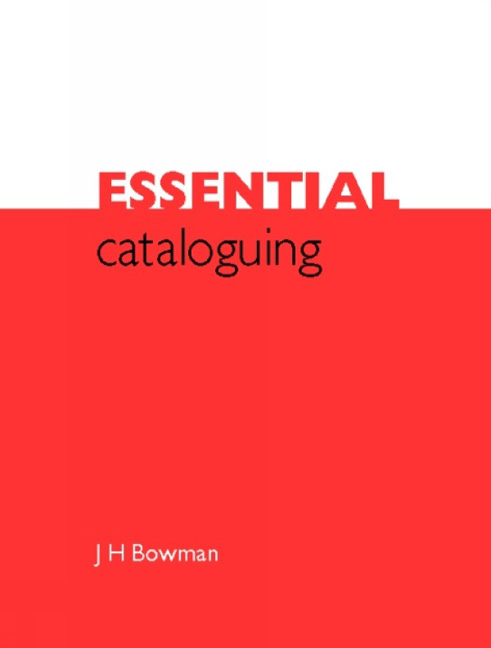Book contents
- Frontmatter
- Contents
- Note to this impression
- Acknowledgements
- 1 Introduction
- 2 Background to cataloguing and AACR2
- 3 Structure of AACR2 and of the MARC 21 format
- 4 Description
- 5 Access points
- 6 Multipart works
- 7 Headings for persons
- 8 Headings for corporate bodies
- 9 Authority control
- 10 Uniform titles
- Bibliography
- Appendix: Catalogue records in MARC 21 format for the examples in this book
- Index
2 - Background to cataloguing and AACR2
Published online by Cambridge University Press: 09 June 2018
- Frontmatter
- Contents
- Note to this impression
- Acknowledgements
- 1 Introduction
- 2 Background to cataloguing and AACR2
- 3 Structure of AACR2 and of the MARC 21 format
- 4 Description
- 5 Access points
- 6 Multipart works
- 7 Headings for persons
- 8 Headings for corporate bodies
- 9 Authority control
- 10 Uniform titles
- Bibliography
- Appendix: Catalogue records in MARC 21 format for the examples in this book
- Index
Summary
This book is designed to help you to use AACR2. But in order to put cataloguing into context it may be useful for you to read this background chapter. If you are really keen to get straight to the practical cataloguing, then by all means skip it.
What is a catalogue?
If you ask someone this, with no particular context, I am sure that the average person will have a mental picture of the answer. It will probably not include a library catalogue, but is more likely to be a catalogue of goods available in a shop or on mail order, such as the Argos catalogue. The mental image will probably be of some specific physical form, perhaps a large paperback book.
In a library context, the physical form of the catalogue is not particularly important. Most present-day catalogues are online, and this makes them far more comparable than they were previously to online information retrieval systems, or to search engines on the world wide web. Online catalogues are likely to continue for the foreseeable future, but in the past there have been printed catalogues, card catalogues, slip catalogues and various microform catalogues, film or fiche. An online catalogue is now usually known as an OPAC (Online Public Access Catalogue), and normally gives a far wider range of access points (ways of looking things up) than any of the previous forms.
Many of the cataloguing rules that we follow today were designed for older physical forms of catalogue, where the labour of providing multiple access points would have been such that they had to be strictly limited. You might feel that some of these rules are now outdated, and you would be right. The fact is, however, that AACR2 still contains them, and this book is based on AACR2. So you will just have to follow them!
Why have catalogues?
It would be an unusual library that had no catalogue of any kind. One reason to have a catalogue is the inventorial, i.e. simply to keep a record of what has been acquired. Some libraries still maintain an accessions register, which just lists brief details of all the items acquired, in the order in which they are received.
- Type
- Chapter
- Information
- Essential Cataloguing , pp. 4 - 11Publisher: FacetPrint publication year: 2003



